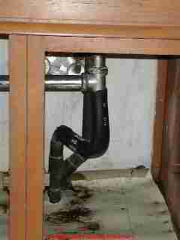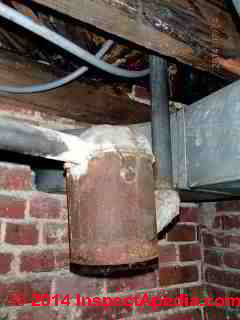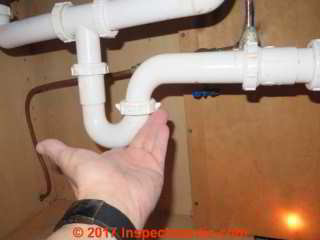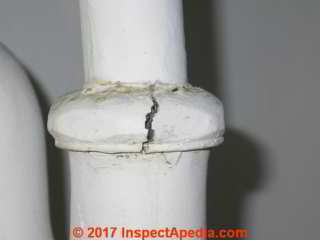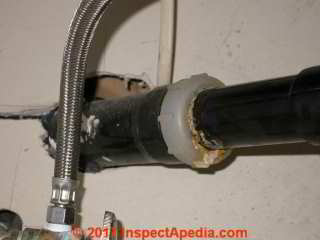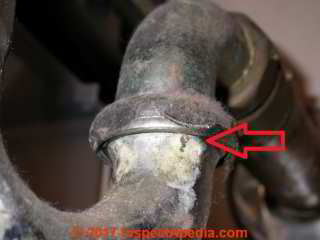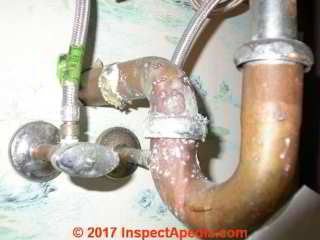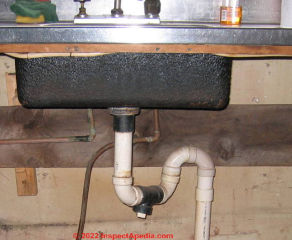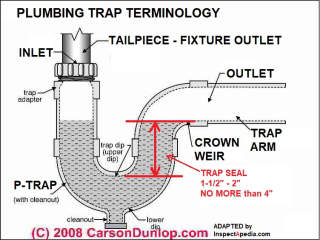 Plumbing Trap Leaks
Plumbing Trap Leaks
Cause & repair interceptor leaks
- POST a QUESTION or COMMENT about plumbing traps or plumbing interceptors
Plumbing drain trap leaks:
This article describes the causes of leaks in plumbing traps (now called plumbing interceptors). We illustrate the locations of leaks and the different types of trap leaks that occur varying by the plumbing trap material: leaks due to loose connections, cracks, or corrosion.
This plumbing traps (interceptors) article series describes plumbing traps (interceptors) and how to diagnose, find, and cure odors in buildings including septic or sewage or sewer gas smells or "gas odors" in buildings with a focus on homes with a private onsite septic tank but including tips for owners whose home is connected to a sewer system as well.
We describe the common problems that occur at plumbing traps: odors, leaks, noises, and we discuss plumbing trap types, requirements, locations, connections, installation, repair and replacement. This article distinguishes between P-traps and older S-traps and explains trap siphonage and the dangers that can result from dry plumbing traps.
InspectAPedia tolerates no conflicts of interest. We have no relationship with advertisers, products, or services discussed at this website.
- Daniel Friedman, Publisher/Editor/Author - See WHO ARE WE?
Leaky Plumbing Trap or Interceptor & Other Defects
Here are some plumbing trap (interceptor) defects to check. Any of these can produce drainage problems and in turn may leak or cause sewer gas or septic odors to be produced in or even outside of a building.
Watch out: Improperly installed, damaged, leaky, or missing plumbing drain traps can release smelly and even dangerous sewer gas odors in the building.
[Click to enlarge any image]
Leaky, Missing, or Improperly Mounted/Located Plumbing Traps / Interceptors: auto radiator hoses & paint cans as plumbing traps?
If you are tracking down building sewer gases or smells don't forget to inspect the building plumbing traps for leaks, defects or improper or missing traps.
The photo at above left shows a plumbing "trap" that is guaranteed to produce odors: it's not a plumbing trap at all, but rather this plumbing drain uses a car radiator hose. This was a great idea for an emergency "Sunday night" plumbing repair, but not something to keep in a home.
Note that there is no bend in the trap to hold a water seal - sewer gases will pass readily out of this sink drain into the building. This home made drain pipe also leaks, as you can see by the black mold on paper located below the sink.
Below we see a rusty paint can enjoying a second career as a plumbing trap. Perhaps this midnight-repair was installed as a stop-gap measure to address a leaky trap. Like topsy this repair just grew and grew with blobs of sealant, lagging, plaster or whatever the repair person found at hand.
Our photo of the paint can plumbing trap was provided by Steve Smallman, a professional home inspector in Raleigh NC.
I suspect that originally there was a galvanized iron plumbing trap at this location - since we see that the surrounding drain piping is galvanized pipe.
Someone got so frustrated with leaks at the plumbing trap that he simply put a paint can around it and filled the can with cement, thinking "OK Buster! Let's see if you leak after I'm done with you!". Of course this repair makes future replacement of the trap or even cleaning it a bit of a chore.
The good news is that often when plumbing traps are leaky from a loose connection the repair may be as simple as gently tightening the coupling nut.
But less good news is that when a plumbing interceptor is cracked or corroded it's time to replace it.
With a bucket under the trap to catch water that will surely spill, remove the trap parts, wipe them off, and carry the lot over to your plumbing supplier to buy new, properly-sized parts to match. That will make reassembly easy.
At PLUMBING TRAP LEAK POINTS we catalog the common leak points at plumbing traps you'll find additional details about tightening the trap connections without breaking them or over-compressing their washers.
Drain Trap Leak Repair Tip
Above I'm checking the white PVC sink trap parts for leaks after repairs to the sink drain.
Run water for 5-10 minutes if you can spare it, then with dry fingers, feel around every sink trap and drain connector nut for water.
That way you may catch and fix a leak before it ruins your kitchen cabinet or bath vanity base.
Where the Plumbing Trap Leaks Occur: Pros and Cons of Plumbing Trap Material Choices
The following OPINION is based on decades of field observations made while inspecting building plumbing systems for leaks, on conversations with plumbers, and by a review of plumbing texts and manufacturer's installation instructions for plumbing traps.
Watch out: one of the most-common causes of leaks at plumbing traps is an over-tightened trap compression nut or "lock nut" that cracks. The manufacturers of ABS and PVC drain interceptors or traps specifically warn against over-tightening for this reason. My photo shows that it's possible to crack even a metal plumbing trap connector.
Above we see leaks at the coupling nut around the connection of the ABS plastic drain trap slip joint connector where it inserts into the ABS building drain.
We don't know if the internal washer was omitted, turned with its beveled edge in the wrong direction, or if the trap coupling nut is too loose, or if it was over-tightened and cracked. When we disassemble this plumbing trap to fix the leak, we will easily discover which of those snafus caused the leak.
Above: it's clear that this chrome-plated brass plumbing interceptor trap is leaking at the coupling nut for the slip joint connector that connects the trap to the building drain.
Over-tightening the trap coupling nut can also squeeze the washer (don't leave that out) located inside of the coupling nut such that it deforms, also causing a leak.
Above: a corroded leaky S-trap.
Chrome-plated brass plumbing traps / interceptors like the plumbing trap shown above, are exposed to corrosion and leakage, like the corroded, leaky chrome-plated, thin-walled S-trap that we show above, found at a kitchen sink in a New York home.
Just how quickly the trap will corrode through to the point of leakage depends on several variables including the corrosivity index of the water being drained, corrosivity of wastes dumped down the drains, and the thickness of the original material.
Brass plumbing traps have the same corrosion risks as chrome-plated plumbing traps & interceptors. Shown above, a corroded, leaky brass plumbing trap I examined in 2005.
Notice that the trap extension, or plumbing trap arm, also properly called the plumbing trap slip joint coupling is simply slip-fit into the horizontal copper drain pipe where that connection was leaking as well.
The chrome-plated brass plumbing trap shown above has corroded so badly that it has fallen apart. All of the sink drainage simply falls into the cabinet below.
Notice the additional clogged material at the upper right bend that connects the trap to the building drain.
I think that leaving a plumbing trap or plumbing interceptor for years with a partial clog is a guarantee of a trap corrosion and leak problem even if the building occupants didn't mind waiting for the sink above to drain.
PVC as well as ABS or for that matter just about any plumbing trap is at risk of leaking at the trap connections to other building drain components like a sink drain basket tailpiece extension insertion into the trap's upper coupling nut (B), or at other trap threaded coupling connectors connectors (C).
But don't mistake a leak at the sink strainer basket (A) for defects in the trap itself. In our photo that stain running down the vertical sink tailpiece extension tells us that there is a leak from above. Not all of the leaks dripping into the plastic bucket under this sink are to be blamed on the plumbing trap.
What about a PVC trap that is made-up out of pieces of 2" PVC drain piping?
Above: this home made sink trap uses PVC piping and a black ABS pipe tee as a "cleanout" for the trap. This home made trap might "work" acceptably but I doubt it.
The engineers who design the shape, dimensions, proportions of a plumbing trap take into consideration the tendency of water to siphon out of a trap and design accordingly. This home made trap is un-vented and looks to me like an S-trap that is at risk of losing its water seal.
More about S-traps is at PLUMBING S-TRAP CODES & HAZARDS
...
Continue reading at PLUMBING TRAP MATERIALS & PROPERTIES or select a topic from the closely-related articles below, or see the complete ARTICLE INDEX.
Or see PLUMBING TRAP, INTERCEPTOR FAQs - questions, answers, comments posted originally at this article
Or see these
Recommended Articles
- PLUMBING TRAPS & INTERCEPTORS - home
- CLOGGED PLUMBING TRAP CAUSE & CURE
- DEFINITION: PLUMBING TRAPS & PLUMBING INTERCEPTORS
- DRY PLUMBING TRAP CAUSE & PREVENTION
- GREASE INTERCEPTORS TRAPS
- LOOSE TOILETS LEAK SEWER ODORS
- PLUMBING TRAP HISTORY
- PLUMBING TRAPS, ILLEGAL
- PLUMBING TRAP LEAKS & MISSING INTERCEPTORS
- PLUMBING TRAP LEAK POINTS
- PLUMBING TRAP MATERIALS & PROPERTIES
- PLUMBING S-TRAP CODES & HAZARDS - separate article
- SEWER GASES vs PLUMBING TRAPS & VENTS
Suggested citation for this web page
PLUMBING TRAP LEAKS & MISSING INTERCEPTORS at InspectApedia.com - online encyclopedia of building & environmental inspection, testing, diagnosis, repair, & problem prevention advice.
Or see this
INDEX to RELATED ARTICLES: ARTICLE INDEX to PLUMBING SYSTEMS
Or use the SEARCH BOX found below to Ask a Question or Search InspectApedia
Ask a Question or Search InspectApedia
Try the search box just below, or if you prefer, post a question or comment in the Comments box below and we will respond promptly.
Search the InspectApedia website
Note: appearance of your Comment below may be delayed: if your comment contains an image, photograph, web link, or text that looks to the software as if it might be a web link, your posting will appear after it has been approved by a moderator. Apologies for the delay.
Only one image can be added per comment but you can post as many comments, and therefore images, as you like.
You will not receive a notification when a response to your question has been posted.
Please bookmark this page to make it easy for you to check back for our response.
IF above you see "Comment Form is loading comments..." then COMMENT BOX - countable.ca / bawkbox.com IS NOT WORKING.
In any case you are welcome to send an email directly to us at InspectApedia.com at editor@inspectApedia.com
We'll reply to you directly. Please help us help you by noting, in your email, the URL of the InspectApedia page where you wanted to comment.
Citations & References
In addition to any citations in the article above, a full list is available on request.
- "Guidance Document for Sizing and Installation of Grease Traps and Interceptors", Carrolton Texas, January 2012, retrieved 2/16/2014, original source: http://cityofcarrollton.com/Modules/ShowDocument.aspx?documentid=8181
- Kia Gregory, "New York Tries to Clear Its Sewers of FOG (Fat, Oil, and Grease)", The New York Times, p. A18, 15 February 2014
- Thanks to Slade Franklin for the reminder that a leaky wax ring at a toilet can lead to septic odors in bathrooms. 11/2007
- Thanks to Roger Hankey & Cheryll Brown, www.hankeyandbrown.com, ASHI home inspectors in Minnesota, for the deteriorated transite pipe gas flue vent photograph and comments. Mr. Hankey is a past chairman of the ASHI Technical Committee, serves as co-chairman of ASHI legislative committee, and has served in other ASHI professional and leadership roles. 7/2007.
- Thanks to Alan Carson and Bob Dunlop, Carson Dunlop, Associates, Toronto, for permission to use illustrations from their publication, The Illustrated Home which illustrates construction details and building components. Carson Dunlop provides home inspection education, publications, report writing materials, and home inspection services. Alan Carson is a past president of ASHI, the American Society of Home Inspectors.
- Our recommended books about building & mechanical systems design, inspection, problem diagnosis, and repair, and about indoor environment and IAQ testing, diagnosis, and cleanup are at the InspectAPedia Bookstore. Also see our Book Reviews - InspectAPedia.
- In addition to citations & references found in this article, see the research citations given at the end of the related articles found at our suggested
CONTINUE READING or RECOMMENDED ARTICLES.
- Carson, Dunlop & Associates Ltd., 120 Carlton Street Suite 407, Toronto ON M5A 4K2. Tel: (416) 964-9415 1-800-268-7070 Email: info@carsondunlop.com. Alan Carson is a past president of ASHI, the American Society of Home Inspectors.
Thanks to Alan Carson and Bob Dunlop, for permission for InspectAPedia to use text excerpts from The HOME REFERENCE BOOK - the Encyclopedia of Homes and to use illustrations from The ILLUSTRATED HOME .
Carson Dunlop Associates provides extensive home inspection education and report writing material. In gratitude we provide links to tsome Carson Dunlop Associates products and services.


